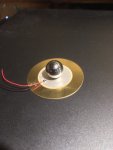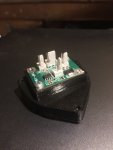rq3
Senior Member
I've borrowed some technology from the auto industry, which uses piezoelectric sensors to determine if an engine is "knocking", or "pinging", so as to adjust the ignition timing to avoid this potentially damaging condition.
My application was to use a common piezo disc to detect the contact of a 3D printer nozzle to its printing bed, without responding to motor noise, acoustical vibration, and the like. It turns out that the solution is mechanical, rather than electrical (or actually a combination of both), but the results are...astounding.
By adhering a small 1/2 inch diameter steel ball to a standard 41mm diameter piezo disc, and supporting the disc by its rim, it becomes very insensitive to acoustic vibration (motor noise, guitar strums, etc.), but very sensitive to axial taps. Gramps Dulcimer Hammer, from a while back, immediately comes to mind as a possible application.
The piezo disc output is diode clipped, low pass filtered, and input to a Picaxe 8M2 ADC. The circuit triggers to do whatever you like at an ADC input above a chosen level.
The 3D printer community has used piezo sensors for many years, with various contortions of clamps, bending, mechanical triggers, torsion, and the like, but I have never seen the addition of a "seismic mass" like mine. It appears to open a entire new realm for these very inexpensive devices.
The posts I made over the past few weeks regarding ADC response times, etc. were in regards to this project, and I really appreciate all of the detailed responses. I hope this very simple, yet apparently functional, modification to a common device helps someone. I can calibrate my 3D printer by nozzle contact alone to levels that the firmware on the printer is incapable of reporting (less than 5 microns, the resolution of the kinematics). A single sensor is adhered under the heated bed of the printer, and detects a BB dropped anywhere on the bed, but does not respond to motor noise or movement.
My application was to use a common piezo disc to detect the contact of a 3D printer nozzle to its printing bed, without responding to motor noise, acoustical vibration, and the like. It turns out that the solution is mechanical, rather than electrical (or actually a combination of both), but the results are...astounding.
By adhering a small 1/2 inch diameter steel ball to a standard 41mm diameter piezo disc, and supporting the disc by its rim, it becomes very insensitive to acoustic vibration (motor noise, guitar strums, etc.), but very sensitive to axial taps. Gramps Dulcimer Hammer, from a while back, immediately comes to mind as a possible application.
The piezo disc output is diode clipped, low pass filtered, and input to a Picaxe 8M2 ADC. The circuit triggers to do whatever you like at an ADC input above a chosen level.
The 3D printer community has used piezo sensors for many years, with various contortions of clamps, bending, mechanical triggers, torsion, and the like, but I have never seen the addition of a "seismic mass" like mine. It appears to open a entire new realm for these very inexpensive devices.
The posts I made over the past few weeks regarding ADC response times, etc. were in regards to this project, and I really appreciate all of the detailed responses. I hope this very simple, yet apparently functional, modification to a common device helps someone. I can calibrate my 3D printer by nozzle contact alone to levels that the firmware on the printer is incapable of reporting (less than 5 microns, the resolution of the kinematics). A single sensor is adhered under the heated bed of the printer, and detects a BB dropped anywhere on the bed, but does not respond to motor noise or movement.
Attachments
-
334.6 KB Views: 19
-
340.1 KB Views: 19
Last edited:


